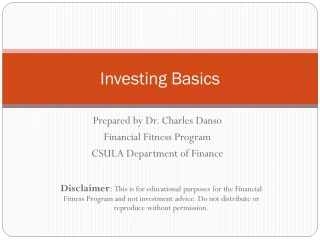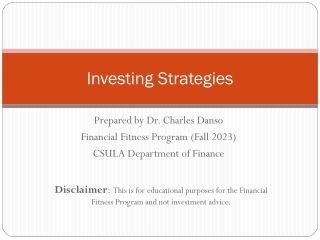Minimalist Art of Investing
Passive investors aim for market average returns with low costs, preferring index-based investments. Active investing involves fund managers picking selective investments to beat the market, but it is costlier and riskier. Choosing between the two strategies depends on individual beliefs and goals in the world of investing.
Download Presentation

Please find below an Image/Link to download the presentation.
The content on the website is provided AS IS for your information and personal use only. It may not be sold, licensed, or shared on other websites without obtaining consent from the author.If you encounter any issues during the download, it is possible that the publisher has removed the file from their server.
You are allowed to download the files provided on this website for personal or commercial use, subject to the condition that they are used lawfully. All files are the property of their respective owners.
The content on the website is provided AS IS for your information and personal use only. It may not be sold, licensed, or shared on other websites without obtaining consent from the author.
E N D
Presentation Transcript
Minimalist Art of Investing Ep 6: Active vs Passive investing Sandeep Tyagi
Recap: First Five Episodes Difficult to predict one year returns, easier to predict over long periods 10 Year Rolling returns: Sensex gave 11.2% CAGR, FD gave 8.2% CAGR 60-40 model portfolio has 10.76% average returns Savings rate of 25 to 40% is healthy Investment Planning for 3 big goals (Templates provided on Gulaq.com): Retirement Planning Buying a home children education Gear based investing: Take risk survey and find out your risk appetite Liquidity needs or goal target date has a significant impact on your asset allocation Get any gear by mixing only two ingredients: Equity and Fixed income
OFFER FOR FREE CONSULTATION Follow us on social me dia Tag us Make a re que st F O LLO W U S O N Sandeep Tyagi GULAQ LinkedIn: https://www.linkedin.com/in/styagi/ LinkedIn: https://www.linkedin.com/in/gulaqnew Twitter: https://twitter.com/styagi Twitter: https://twitter.com/gulaqfintech Instagram: https://www.instagram.com/gulaqfintech/
Active vs Passive investing 1 Year Return 21-Apr-2022 The biggest difference between passive BAJAJFINSV DIVISLAB TECHM and active investing is that active ADANIENT BAJFINANCE TATACONSUM investing involves picking selective TCS UPL investments with an objective to beat ASIANPAINT HDFCLIFE HCLTECH index, whereas passive investing NIFTY SBILIFE TITAN POWERGRID typically tracks an index. NTPC HEROMOTOCO MARUTI ULTRACEMCO AXISBANK COALINDIA INDUSINDBK BAJAJ-AUTO EICHERMOT HDFC LT ITC -80 -60 -40 -20 0 20 40 60 80
Passive investing Passive investors aim to earn market average returns. They assume its tough to beat the average, hence would prefer investing in index. Cost of passive investing is low compared to active investing Active managers charge fee, which is low/none in passive investing The cost in terms of Time and efforts required is also low in passive investing After the deduction of the costs of investing, beating the stock market is a loser s game. - John Bogle, Founder of Vanguard Group
Active Investing If you believe that you or your advisor is better than the average investor, active investing makes sense. Alpha generation is the primary objective of active investing In Active investing, fund managers picks a set of investments Based on performance, fund managers regularly updates portfolio to optimise returns Since it involves active efforts of fund manager, active investing is expensive Risk is higher Fund manager tries to beat the benchmark, and all can t do that
Active vs Passive investing Which investing style would you prefer? a) Active b) Passive c) Mix of both
Active Investing Analysis of Profit and Loss of Individual Traders dealing in Equity F&O Segment --Published Jan 25, 2023 (available on their website) FY19 FY22 This does not even include transaction costs. The Total No. of individual traders 7,06,757 45,24,841 numbers are worse (maybe half with that) (sample) Loss makers made INR 1.1 L loss % of Total 100% 100% Profit makers (11% of total) made INR 1.78 L in profit % of Loss makers during the year 85% 89% Does this seem like a gamble you would want to take? % of Profit makers during the year 15% 11%
Active Investing The Bet If you think professional fund managers can help you beat market, we got an interesting case of Prot g Partners, a fund of funds, whose job it is to find sophisticated hedge funds to invest in. Warren Buffet famously bet against Prot g Partners in 2008 The bet is S&P 500 will outperform the investment in 5 selected funds by Prot g Partners in next decade During the bet period, the group of hedge funds made 22.4% returns vs S&P 500 s 85.4% The group of hedge funds outperformed index only 2 out of 10 years On the other hand, Warren Buffet himself is an active investor. He outperformed S&P 500 regularly, and produced 2X returns compared to S&P 500 from 1965 to 2021.
Active Investing Patience and Conviction Berkshire outperformed S&P by more than 100% over 20 years period, but underperformed in 5-year period (2016 2021) *Source: Seeking Alpha, Period: 2001-2021
Investment Needed Teams or investors who can generate ALPHA spend a lot to get there Estee has 135 employees many with IIT, IIM or foreign degrees Estee has over 100 servers, and access to 1000 s of machines in Google cloud Estee spends nearly INR 2 Crore buying and managing data Yes, with that, we can produce alpha over the index!
Evaluating Active Fund managers Percentage of Indian Active Equity large cap funds failed to beat benchmark over last 3 years? a) 89% b) 64% c) 51% d) 36%
Evaluating Active Fund managers Percentage of Indian Active funds underperformed vs benchmark 1-year 5-year 10-Year 100% 80% 60% 40% 20% 0% Large Cap Mid/Small cap *Source: SPIVA, Data as on 12/31/2022
Evaluating Active Fund managers Benchmark performance Costs Volatility At Gulaq, we have 6 Gear based portfolios with different asset allocation. Each portfolio has unique risk to reward ratio, to serve wide range of investor categories.
Evaluating Active Fund managers - Costs Investment growth - high vs low fees Types of costs involved: Advisory fee, Brokerage fee, Admin fee, etc., 1,500,000 Fees, Transaction costs eat up large part of returns over long term Have a rough idea about how much % of AUM is your fee 1,000,000 Returns should be higher than benchmark returns + fees % An average large-cap mutual fund has a total expense ratio of 2.15% Expense ratio range of Large-cap mutual funds 1.54% to 2.67% 500,000 For index funds, expense ratio is as low as 0.06% 0 2.67% Manager 1.54% Manager
Evaluating Active Fund managers - Volatility Typically funds with good recent performance only advertise their recent performance Hence, its recommended to see the historical performance for mid to long term For Equity funds, at least investors should look at 3 years returns Additionally, check how the fund has performed in different market cycles Funds which are based on single factor models, tend to outperform market in favourable conditions, and underperform in other conditions Same is the case with a specific theme based or sector based funds
Active vs Passive Which suits better? Active or Passive investing are two different investment styles. The following are some traits we can attribute to these two investing styles. Active Investing Passive Investing Objective Beat Markets Grow with Markets Risk High Low Returns Can be High Medium Efforts Required Very High Low Costs High Low Diversification Medium High Attitude Aim for the best Slow & Steady
Coming Episode Avoiding Noise - Emotions of investing - Technical Indicators - Sector or Factor Investing
Thank You F O LLO W U S O N Sandeep Tyagi GULAQ LinkedIn: https://www.linkedin.com/in/styagi/ LinkedIn: https://www.linkedin.com/in/gulaqnew Twitter: https://twitter.com/styagi Twitter: https://twitter.com/gulaqfintech Instagram: https://www.instagram.com/gulaqfintech/























